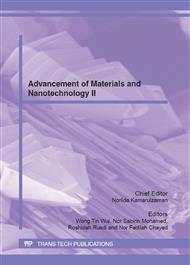[1]
K.D. Kreuer, Chem. Mater. 8 (1996) 610.
Google Scholar
[2]
A.J. Appleby, in: D. Doughty, B. Vyas, T. Takamura, J.R. Huff (Eds.), Material for Electrochemical Energy Storage and Conversion-Batteries, Capacitors and Fuel Cells, Vol. 393, Material Research Society, Pittsburgh, Pennsylvania, 1995, p.11.
DOI: 10.1002/maco.19960471117
Google Scholar
[3]
A. Bozkurt and W. H. Meyer (2001). Solid State Ionic, 138, 259-265.
Google Scholar
[4]
J. C. Lassegues, J. Grondin, M. Hernadez and B. Maree (2001), Solid State Ionic, 145, 37-45.
Google Scholar
[5]
M. Hema, S. Selvasekerapandian, A. Sakunthala, D. Arunkumar and H. Nithya (2008), Physica B, 403, 2740-2747.
DOI: 10.1016/j.physb.2008.02.001
Google Scholar
[6]
A. M. M. Ali, N. S. Mohamed and A. K. Arof (1998) , Journal of Power Sources, 74, 135-141.
Google Scholar
[7]
C. S.Ramya, S. Selvasekarapandian, T. Savitha, G. Hirankumar and P. C. Angelo (2007). Physica B, 393, 11-17.
DOI: 10.1016/j.physb.2006.11.021
Google Scholar
[8]
S A Hashmi, Ajay Kumar, K K Maurya and S Chandra, J. Phys D; Appl. Phys. 23 (1990) 1307-1314
Google Scholar
[9]
M.F.Z. Kadir, S.R. Majid, A.K. Arof, "Plasticized Chitosan-PVA Blend Polymer Electrolyte Based Proton Battery" Electrochimica Acta, In Press, 13 May (2009)
DOI: 10.1016/j.electacta.2009.05.011
Google Scholar
[10]
R.H.Y. Subban, A.K. Arof, European Polymer Journal 40 (2004) 1841-1847
Google Scholar
[11]
S.Rajendran, T. Uma, Ionics 7 (2001) 122-125
Google Scholar
[12]
S.Rajendran, Ravi Shanker Babu, P.Sivakumar, Journal of Membranes Science 315 (2008) 67-73
Google Scholar
[13]
A. Mary Sukeshini, Atsushi Nishimoto, Masayoshi Watanabe, Solid State Ionics 86-88 (1996) 385-383
DOI: 10.1016/0167-2738(96)00156-7
Google Scholar
[14]
M.H. Buraidah, L.P. Teo, S.R. Majid, A.K. Arof, Physica B 404, 1373-1379 (2009).
Google Scholar
[15]
R.H.Y. Subban, J. New. Mat. Electrochem. System 6, 197-203 (2003).
Google Scholar
[16]
B.Choi, K. Shin, Solid State Ionics 86, 303 (1996)
Google Scholar
[17]
M. Beltran and A. Marcilla, European Polymer Journal, Volume 33, Issue 8, Pages 1271-1280, (1997).
Google Scholar
[18]
W.O. George, P.S. Mcintyre: Infrared Spectroscopy,edited by David J. Mowthorpe, (1990)
Google Scholar
[19]
Chintapalli S, French R (1996) Solid State Ionic 86–88:341–346
Google Scholar
[20]
S.Ramesh , G.P. Ang, Ionics 16 : 465-473 (2010)
Google Scholar
[21]
S.F Mohamad, Razali Idris, N.S. Mohamed, Advanced Material Research, Vol (129-131) P. 561-565.
Google Scholar


